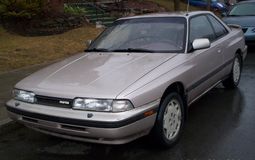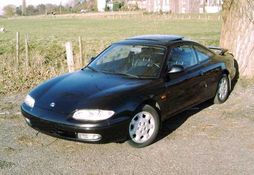The History Of Mazda MX-6

The Mazda MX-6 was a front-wheel drive sporty coupé produced by Mazda between 1987 and 1997. It was called the Mazda Capella in Japan until 2002 before being renamed Mazda Atenza/ Mazda6.
The MX-6 was mechanically identical to the Mazda 626 and subsequently the Ford Probe. These cars shared the GD (1988-1992) and GE (1993-1997) platforms. The MX-6 replaced the 626 Coupé, although it continued to share the same chassis. Mazda shared the GD and GE chassis with Ford for their own Probe. The MX-6, 626 and Ford Probe were made together in joint-venture plants either by AutoAlliance in Flat Rock, MI for the North American market, and by Mazda Japan for Asian and European Markets.
The first generation MX-6 appeared in 1988 and lasted until 1992 in the United States. In some markets the model years were from 1987 to 1991. It was based on a series of futuristic sports compact concept cars of the early 1980s. It was a large coupé, based on the Mazda GD platform, and was powered by the I4 Mazda F engines.
The US market made use of the F2 2.2L engine, with the base engine produced 110hp (82kW), but a 145hp (108kW) turbocharged version was available. European and Japanese market versions were shipped with either the F8 1.8L, FE 2.0L or FE-DOHC 2.0L DOHC engines.
The MX-6 was produced with two transmission options, a 5-speed manual transmission or a 4-speed automatic with overdrive. The MX-6 was also known to be a very reliable car, mechanically.
This generation was available in several trim levels, which differ depending on the market the vehicle was sold in. In the United States, the MX-6 was available in DX, LX, LE, and GT trim levels:
- DX was the "bare bones" model, offering the base 120hp (89kW)/ 130lb·ft (176N·m) F2 2.2L engine and few options, but most MX-6s sold in the U.S. were equipped with air conditioning.
- LX added power windows, power locks, and power mirrors, as well as an optional electric moonroof.
- LE was a rare "Leather Edition" model that was the same as the LX, but included leather seating surfaces and a leather wrapped shift knob on manual transmission-equipped vehicles.
- GT included all options from the LX, but also stepped up to the F2T 2.2L turbocharged, intercooled engine, which put out 145hp (108kW) and 190lb·ft (258N·m) of torque delivering a significant performance boost. It also had 4 wheel disc brakes with ABS as optional, and 3 way electronically adjustable suspension, dubbed AAS.
In 1989, Mazda offered a special four wheel steering (commonly abbrieviated 4WS) option on MX-6 GTs destined for the U.S. This system consisted of an electronically controlled rear steering rack that turned the rear wheels opposite to the fronts at low speeds to improve cornering, and turned the rear wheels with the fronts at high speeds to improve highway lane change maneuvering. This option was available through all years for GT models in other markets.
European spec vehicles shipped as the 626 Coupé and commonly received either the 1.8L SOHC F8 or 2.0L SOHC FE engine in GLX models, or the 2.0L FE-DOHC engine in their GT models. 4WS was a common option for European 626 Coupés. Australian vehicles were almost always equipped with the 2.2L turbocharged F2T engine as the US models, as well as 4WS. They also carried the MX6 name of the American models.
Asian spec vehicles were shipped as the Capella C2 and were available in several trims, most notably GT-R (FE-DOHC and 4WS), GT-X (FE-DOHC and AAS) or GT-S (F8 and 4WS or AAS).
New Zealand received vehicles in either European spec or Australian spec, selectable on order. As such, NZ GTs can have either the F2T 2.2L turbocharged engine or the FE-DOHC 2.0L DOHC, with optional 4WS.
In 1992 Mazda unveiled the new MX6, commonly referred to as the second generation. It used the new GE platform, shared by the 626 and Ford rebadged cars, the Ford Probe and the Ford Telstar. It was released in three distinct variants worldwide, known as A-spec, E-spec and J-spec, which relates to their destined markets – US, Europe and Japan, respectively.
A-spec
The A-spec variant was for the North American market only. It was built alongside the Ford Probe and Mazda 626 from 1992 as a 1993 model by AutoAlliance International in Flat Rock, Michigan. There were three trim levels available on the A-spec models:
- 'RS' - Base model, fitted with the FS-DE 2.0 DOHC I4 engine, making 118hp (88kW).
- 'LS' - Luxury model, fitted with the KL-DE 2.5 DOHC V6 engine, making 164hp (122kW). It was also equipped with alloy wheels, a low rear spoiler, an optional cd player, foglights and leather or cloth interior.
- 'LS M-edition' - A special edition based on the LS, including different, all-red tail lights, chrome scuff plates, an indash 3-disk CD stacker, gold alloy wheels (same design as LS), all gold badges, and M-edition embroidered on the front seats and floor mats. M-editions only came in three paint colors: a trim exclusive burgundy , black, and white. All with cream leather interior and special gold pin striping.
In 1995 the second generation MX6 was refreshed with different 5-spoke alloy wheels, twin airbags and emissions changes.Another major change after 1995 was the addition of OBD-II to the car. With this addition the 164hp (122kW) was decreased to 160hp (120kW) for every year thereafter. Known as the 'GE2', this model ran until 1997. Interesting to note is that unlike the first generation, the second generation MX6 only had one model with a different moniker - the Canadian MX-6 Mystére.
E-spec
Built from 1991 in Japan, for Australia, New Zealand, and Europe. Compared to the A-spec, it has different headlights (a two-piece projector setup giving far greater lighting) and taillights, different front and rear bumpers, fog lights, wing-mirrors (power+heated), steering wheel, interior trim and alloys as standard. The side indicator lights were mounted behind the front wheels, and there are no corner bumper lights. It also came with optional air conditioning and leather interior (standard from 96), and the MX6’s main act – the 4WS system (not available in the UK). The engine was the same as the US version (although not limited by lower octane fuels) – the KL-DE 2.5 DOHC V6 engine, again making 164hp (122kW) and with the higher octane fuels used in Europe as standard, slightly lower mpg but with greater performance.
In Australia, the MX-6 was released in November 1991. Only one trim was available. Equipped with the KL-DE 2.5 DOHC V6 engine, sunroof, 4WS etc., with the only remaining options being leather and electric seats. September 1994 was the release of the GE2 update model. Like Mazda Australia did with the GD2, there were now two choices – the 4WS all options MX6, or the 2WS version. They both had new wheels, interior trim, and steering wheel, but only the 4WS version got the sunroof, CD player, leather (which actually only became standard in late '96) and the digital climate control. The MX-6 lasted until 1997, with the last few rolling out of dealers in 1998.
J-spec
This version was also released in 1991, and is very similar to the E-spec (as they are built in the same place), but with minor changes. One piece headlights were fitted, with indicators incorporated in the fog light housing, as well as a different rear bumper with smaller registration plate cutout, similar to the A-spec. Almost everything was an option, but the 4WS was available, as well as the digital climate control, electric folding mirrors, larger centre console, and of course, the Mazdaspeed body add-ons – a subtle lip kit with Supra-style high rise rear spoiler.
Engine choice was the KL-ZE 2.5 DOHC V6 making 200bhp (150kW), a high compression version of the KL-DE, or the KF-ZE 2.0 DOHC V6 making 159bhp (119kW), all of the K series engines in the MX6 were based on the same engine block and included those found in the Ford Probe, Xedos 6 and MX-3 V6 models..
The J-spec MX6s are now quite common around the world, from the UK to Australia and NZ, with the KL-ZE engine conversion alone being popular worldwide.
Used from 1987-1997 on the majority of MX-6s around the world[citation needed], this was the MX-6s centerpiece. It was available on both generations, although the North American market only received it for the 1989 model year. South African MX-6s never received 4WS. According to Mazda, the system provided:
- Superior cornering stability
- Improved steering responsiveness and precision
- High-speed straightline stability
- Notable improvement in rapid lane-changing maneuvers
- Smaller turning radius and tight-space maneuverability at low vehicle speed range
The system electronically controlled a rear rack that was behind the rear wheels. At low speeds (of up to 35km/ h), the rear wheels would move in the opposite direction to the front wheels, aiding parking and U-turns by lowering the turning circle. Above these speeds, the rear wheels would move in the same direction as the fronts, meaning control during high speed manoeuvres such as lane changes or cornering was improved. Either way, the turning angle of the rear wheels was slight at just five degrees, a measurement Mazda determined to be optimally effective and natural to human sensitivity. Note:
- When the engine is turned off, the rear wheels would straighten up. They would change back to the angle of the front wheels when the engine is restarted. This is caused by the 4WS control unit powering down, and the failsafe system overriding the rear rack.
- If the system ever faults, as a failsafe the rear wheels would lock straight to allow the vehicle normal 2WS functionality.
From Wikipedia, the free encyclopedia
More About Mazda MX-6



|